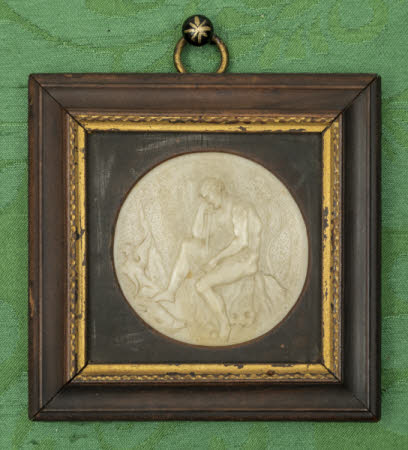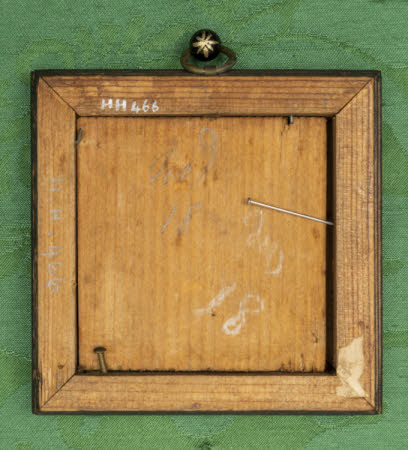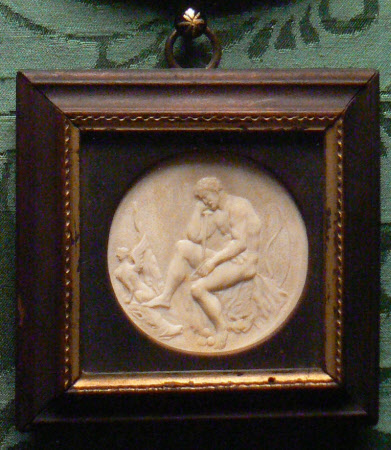Hercules at rest, with emblems of his Labours
Category
Art / Sculpture
Date
c. 1740 - 1750
Materials
Ivory, Wood
Measurements
92 mm (H)86 mm (W)
Place of origin
London
Order this imageCollection
Ham House, Surrey
NT 1140236
Summary
Ivory; Hercules at rest; British; c. 1740-50. A circular ivory medallion depicting the Classical hero Hercules seated, surrounded by objects referring to his Labours. Sunk deep in thought, and at far left a winged sphinx. One of five ivory portrait and subject reliefs within a single frame, in the Green Closet of Ham House.
Full description
A circular carved ivory relief depicting the Classical hero Hercules. He is naked and seated on a rock covered by the pelt of the Nemean lion, which Hercules slew in the first of his Labours. Hercules seems to be in pensive mood; using his right hand to support his chin. In this hand he also holds a sword, with the point downwards. Behind the rock is his bow, below his feet three golden apples of the Hesperides and at lower left on the ground a boar’s head, representing the Erymanthean Boar, which the hero captured as one of his other Labours. The apples seem to have rolled out from a bag that Hercules holds in his left hand. At far left a bare tree trunk points upwards and, seated by it and facing away from Hercules, a small figure of a winged sphinx. The background stippled throughout. In a rectangular ebonised wood frame with gilt-wood fillets. The small circular relief is kept along with four ivory portraits of members of the Carteret and Tollemache families in the Green Closet. Although it would seem to date from around the same time as the portrait reliefs, the mid eighteenth century, the Hercules is in a very different frame, so may not have been made to go with them. The iconography of the object is somewhat obscure and difficult to explain. The central figure would seem very clearly to represent the Classical hero Hercules, who is sometimes depicted resting after his Twelve Labours. Here he is shown surrounded by attributes associated with him and some of these Labours: the skin of the Nemean Lion; his bow; a boar’s head referring to his capture of the Erymanthean boar; and three apples for the golden apples he was sent to steal from the Garden of the Hesperides. More puzzling is the fact that none of the numerous Hercules legends make reference to the sphinx, seen at the far left, nor is Hercules otherwise generally shown holding a sword, as he is here. The hero Oedipus is more normally shown with the sphinx, whose riddle he deciphered, but with the attributes seen here, it would seem unlikely that he is the figure represented. The relief has presumably long been together with the ivory portrait medallions at Ham, and is likely like them to have been made around the middle of the eighteenth century and probably in London, perhaps by an immigrant sculptor from Flanders or France. One possible candidate might be the Antwerp-born Gaspar van der Hagen (active 1744-1769), who worked for a time in Michael Rysbrack's workshop and made sculptures in both marble and ivory. Jeremy Warren January 2022
Provenance
Presumably the 4th Earl and Countess of Dysart; thence by descent, until acquired in 1948 by HM Government when Sir Lyonel, 4th Bt (1854 – 1952) and Sir Cecil Tollemache, 5th Bt (1886 – 1969) presented Ham House to the National Trust. Entrusted to the care of the Victoria & Albert Museum until 1990, when returned to the care of the National Trust, to which ownership was transferred in 2002.



